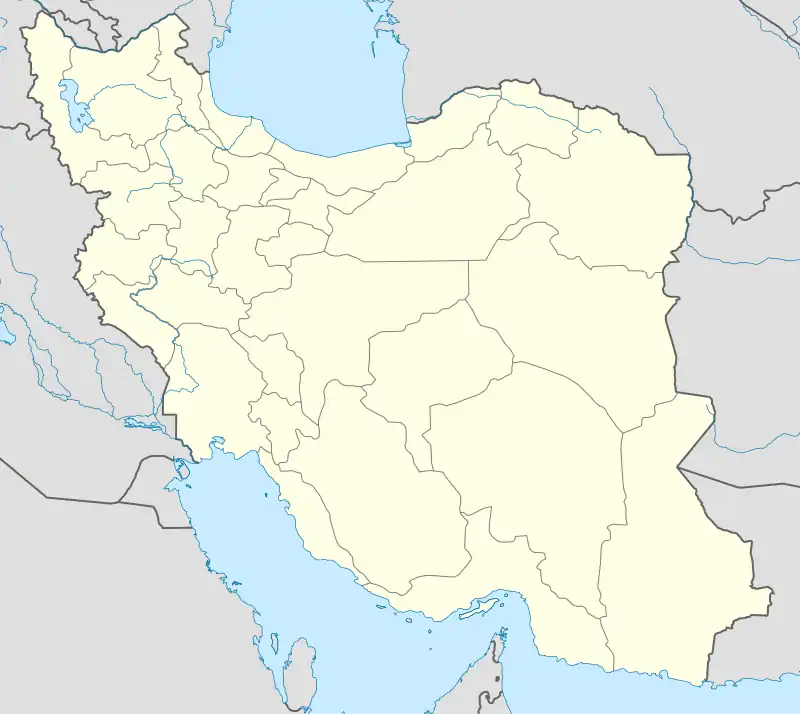| Chahar Padshahan | |
|---|---|
 | |
| Religion | |
| Affiliation | Twelver Shi'a, Zaydi Shi'a |
| Province | Gilan |
| Location | |
| Location | Lahijan, Iran |
 Shown within Iran | |
| Geographic coordinates | 37°12′13″N 49°59′55″E / 37.2035643°N 49.9984876°E |
| Architecture | |
| Type | mausoleum |
| Style | Safavid |
| Completed | 13th-century origin; current structure is a Safavid-era building |
| Materials | clay brick |
Chahar Padshahan (Persian: مسجد چهار پادشاهان, "Four Kings") is the name of a historic mausoleum in Lahijan, Iran, where four rulers of the Karkiya dynasty are buried.[1][2] It is number 322 on the list of national monuments of Iran.[1][2] Despite being intended as a mausoleum, the Chahar Padshahan is also used as a mosque.[1][2]
History
The building was originally a mausoleum for the ancestor of the Karkiya dynasty, Seyyed Karkiya, who died in 1250, and a tomb was established for him immediately after he died.[1] After the demise of Karkiyid ruler Ali-Kiya, he was buried in the mausoleum too, next to Seyyed Karkiya.[1] Then his son, Reza-Kiya, was buried there next to him, following him, his brother Razi-Kiya was also buried there, next to him.[1][2] The Karkiyid ruler Hady-Kiya helped to expand and renovate the mausoleum where he buried his brothers in.[2] During the Safavid period (before Shah Abbas' rule) the mausoleum was constructed and expanded.[1] At some point, during the era of the Qajar rule, the mausoleum was renovated and tiled up.[1]
Architecture

The main building of Chahar Padshahan is rectangular, with four rooms, and as well as a porch facing the north direction.[1] The building has two main entrances, and the main building, the mausoleum itself, is located on the south side of the yard. The entrance doors are made of polished wood.[1][3] This building is tiled extensively, with the tilework dating back to the Qajar period.[1][3]

The Karkiyid rulers are buried in a central room. In this room, their graves are enclosed by a wooden zarih.[1][3] The larger room, next to the tomb room, is used as a prayer hall for a mosque.[1][3]
Gallery
 Paintings of the Karkiyid rulers on the upper part of mausoleum's entrance
Paintings of the Karkiyid rulers on the upper part of mausoleum's entrance A door leading to the mausoleum's tomb room
A door leading to the mausoleum's tomb room A copyright infringement notice, which is framed honorably
A copyright infringement notice, which is framed honorably A view from the main building's porch, showing the Jameh Mosque of Lahijan across the street
A view from the main building's porch, showing the Jameh Mosque of Lahijan across the street
See also
References
- 1 2 3 4 5 6 7 8 9 10 11 12 13 "مسجد چهار پادشاهان - مجله مِستر بلیط" (in Persian). Retrieved 2023-12-09.
- 1 2 3 4 5 "مسجد چهار پادشاهان لاهیجان – جاذبه های گردشگری ایران و جهان با راهنمای سفر ☀️ این تودی". intoday.ir. Retrieved 2023-12-09.
- 1 2 3 4 "بقعه چهار پادشاهان لاهیجان با معماری و تزئینات دیدنی ، یادگار دوره صفوی | ویلارابط" (in Persian). Retrieved 2023-12-09.
- Sotoudeh, Manouchehr (2001). "Gīlān ix. Monuments". Encyclopaedia Iranica, Vol. X, Fasc. 6. pp. 650–659.